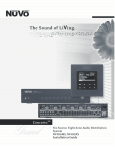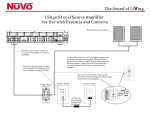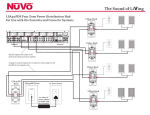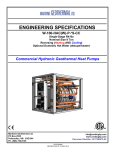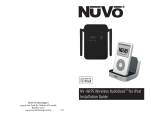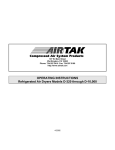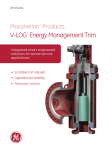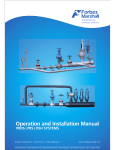Download gvdm-26 domestic hot water desuperheater pump module kit
Transcript
INSTALLATION INSTRUCTIONS GVDM-26 DOMESTIC HOT WATER DESUPERHEATER PUMP MODULE KIT Bard Manufacturing Company, Inc. Bryan, Ohio 43506 Since 1914...Moving ahead just as planned. © Copyright 2009 Manual No.: Supersedes: File: Date: 2100-517 NEW Volume I, Tab 9 02-06-09 Manual Page 2100-517 1 of 11 CONTENTS General ................................................................. 3 Description ............................................................ 3 Location ................................................................. 3 Electrical Connection ............................................. 3 Soldering Tubing ................................................... 3 Installation Procedure – General ........................... 3 Operation of the Heat Recovery Unit .................... 4 Start Up and Check Out ........................................ 4 Maintenance .......................................................... 4 Control Board Sequence of Operation ................ 10 WIRING DIAGRAM ............................................................ 5 FIGURES Figure 1 Figure 2 Figure 3 Figure 4 Figure 5 Figure 6 Mounting Directly onto Unit ................. 6 Air Purge Port ...................................... 7 Remote Mounting & Piping .................. 8 Single Tank System ............................. 9 Thermistor ......................................... 10 Replacement Parts ............................ 11 COPYRIGHT FEBRUARY 2009 BARD MANUFACTURING COMPANY, INC. BRYAN, OHIO USA 43506 Manual 2100-517 Page 2 of 11 GENERAL INSTALLATION PROCEDURE – GENERAL The pump module kit should only be installed by trained technicians. These instructions serve as a guide to the technician installing the pump module kit. They are not intended as a step-by-step procedure with which the mechanically inclined owner can install the unit. Before beginning the installation, turn off all power supplies to the water heater and unit, and shut off the main water supply line. DESCRIPTION The system is designed to heat domestic water using heat recovered from a water source unit’s hot discharge gas. LOCATION There are two options for the mounting location of the GVDM-26 Domestic Hot Water Desuperheater Module. First, there are pre-punched mounting holes for it on the side of the geothermal heat pump beneath the filter rack. Factory supplied in the kit are interconnect tubes that connect the pump module to the water source unit (See Figure 1). The second is to locate the GVDM-26 on a wall adjacent to the geothermal unit or storage tank/water heater. (See Figures 3 and 4.) Because of potential damage from freezing or condensation, the unit must be located in a conditioned space, therefore the GVDM-26 must be installed indoors. Locate the storage tank as close to the geothermal heat pump and pump module as the installation permits. Keep in mind that water lines should be a maximum of 25 feet long measured one way. Also, the vertical lift should not exceed 20 feet. This is to keep pressure and heat losses to a minimum. ELECTRICAL CONNECTION The GVDM-26 is equipped with a standard 115V 3-prong plug. The unit is rated at .9 amps and can normally be plugged into any convenient electrical outlet. TWO TANK – In order to realize the maximum energy savings from the heat recovery system, it is recommended that a second water storage tank be installed in addition to the main hot water heater. Fossil fuel fired water heaters must be a two-tank installation. Tanks specifically intended for hot water storage are available from water heater manufacturers (solar hot water storage tanks). A well insulated electric water heater without the electric heating elements will also make a suitable storage tank. The size of storage tank should be as large as space and economy permit but in no event should it be less than one-half of the daily water requirements for the occupants. As a guide in estimating the daily family water requirements, The Department of Energy recommends a figure of 16.07 gallons of hot water per day per individual. For example, a family of four would require 64.3 gallons per day (4 x 16.07). ONE TANK – The single hot water tank may be a new hot water heater (sized to 100% of daily water requirements) or the existing water heater in the case of a retrofit installation. The existing water heater should be drained and flushed to remove all loose sediment. This sediment could damage the circulating pump. The bottom heating element should be disconnected. NOTE: Make sure water heater thermostats are set below 125° on One Tank Unit. WATER PIPING – All water piping must adhere to all state and local codes. Refer to piping diagrams for recommended one and two tank installations. Piping connections are 1/2 inch nominal copper plumbing. A cleanable “Y” type strainer should also be included to collect any sediment. NOTE: Make sure outlet is grounded, and that the circuit will handle the added load. If any concerns in this regard you should run a separate grounded circuit to the main panel. SOLDERING TUBING NOTE: The “inlet” and “outlet” thermistors should be removed from the tubes prior to soldering/ brazing operation so they are not damaged. They are clipped onto the “DSH COIL INLET” and from “DSH OUTLET” tubes of the GVDM26 Module. Once soldering operations are complete, and the tubes have cooled, reattach the sensors and wrap with provided insulation. WARNING Never alter or plug factory installed pressure relief valve on water heater or auxiliary tank. Manual Page 2100-517 3 of 11 OPERATION OF THE HEAT RECOVERY UNIT START UP AND CHECK OUT The pump module is a very simple device containing basic controls and a circulating pump. Heat is transferred from the hot refrigerant (discharge gas) to the cool water. The operation of the Desuperheater Pump Module is controlled first by the operation of the Geothermal Heat Pump and secondly by internal controls within the Pump Module. A low voltage signal from Thermostat “Y” is connected to the internal control board of the GVDM-26 and acts as the primary on/off switch for the circulating pump. Also connected to this board is a temperature overlimit device which shuts down the GVDM-26 once inlet water has exceeded 125° so the water cannot create a scald condition. There are also two (2) thermistor sensors connected to the control board. These thermistors are measuring and controlling to ensure there is a positive heat differential across the water being circulated. When operating in Part Load Condition, there are certain conditions (Ground Loop Temperatures versus Hot Water Temperatures) that potential exists where heat could transfer from the hot water into the refrigeration system instead of the refrigeration system into the hot water. Through the control board logic, these thermistors ensure there is at least 2° positive differential between entering/leaving water temperatures and will shut down the pump accordingly. Be sure all shut off valves are open and all power supplies are on. Open a hot water faucet to permit any air to bleed from the plumbing. Manual 2100-517 Page 4 of 11 NOTE: The inherent design of this pump for maximum efficiency means this pump is not self-priming. It is imperative to check that the air has been adequately bled from the system. There is a bleed-port built into the pump module that can be utilized after the system water has been fully restored. See Figure 2 for this bleed port location. Turn ON the air conditioning system and verify the circulating pump will operate. Feel the “Water to Unit” and “Water from Water Heater” tubes for noticeable difference in temperature. Turn OFF the system and verify that the circulating pump stops. NOTE: When checking the refrigerant operating pressures of the ground source heat pump. The GVDM-26 must be turned off. With the GVDM-26 operating a wide variance in pressures can result, giving the service technician the indication there is a charge problem when the unit is operating correctly. MAINTENANCE CLEANING THE HEAT EXCHANGER – If scaling of the coil is strongly suspected, the coil can be cleaned with a solution of phosphoric acid (food grade acid). Follow the manufacturer’s directions for the proper mixing and use of cleaning agent. WIRING DIAGRAM 3 AMP FUSE OUTLET THERMISTOR THERMISTOR OVER TEMP. LIMIT L GREEN WHITE BLACK N WALL PLUG WATER SENSORS NC BLUE BLUE BLUE BLUE BLACK BLACK N PUMP OUTLET C NO INLET TSTAT CONTROL LOGIC LINE VOLTAGE PUMP MOTOR DESUPERHEATER PUMP CONTROL Y POWER L BLACK WHITE C 24VAC 24 VAC R YELLOW RED BLACK FACTORY WIRING FIELD WIRING LOW VOLTAGE HIGH VOLTAGE BI-METAL TEMPERATURE LIMIT 4053-113 Manual Page 2100-517 5 of 11 Figure 1 MOUNTING DIRECTLY ONTO UNIT FILTER ASSEMBLY DESUPERHEATER PUMP MODULE ATTACH TO UNIT USING PROVIDED SCREWS INLET AND OUTLET TUBES SUPPLIED WITH PUMP MODULE MIS-2647 Manual 2100-517 Page 6 of 11 Figure 2 AIR PURGE PORT AIR PURGE PORT NOTE: PUMP IS NOT SELF-PRIMING, IT I S RECOMMENDED TO MANUALLY BLEED-OFF AIR. INLET FROM WATER HEATER FROM DSH COIL OUTLET INLET THERMISTOR NOTE: REMOVE DURING TUBE SOLDERING, THEN RE-INSTALL AND WRAP WITH PROVIDED INSULATION. OUT TO WATER HEATER OUT TO DSH COIL INLET OUTLET THERMISTOR NOTE: REMOVE DURING TUBE SOLDERING, THEN RE-INSTALL AND WRAP WITH PROVIDED INSULATION. NOTE: INSTALLER MUST INSURE THAT THE INLET THERMISTOR IS RE-LOCATED BACK TO THE INLET TUBE AND THE OUTLET THERMISTOR IS LOCATED BACK ON THE OUTLET TUBE. VERIFY BY CONNECTIONS ON CONTROL BOARD MIS-2651 Manual Page 2100-517 7 of 11 Figure 3 REMOTE MOUNTING & PIPING Manual 2100-517 Page 8 of 11 Figure 4 SINGLE TANK SYSTEM Manual Page 2100-517 9 of 11 CONTROL BOARD SEQUENCE of OPERATION The desuperheating control board will make a determination whether or not to energize the pump relay inclusive on the control board. A. It will constantly monitor inputs from two temperature sensors, Inlet & Outlet water sensors. B. It will constantly monitor the Y signal. C. Upon acknowledgment of Y signal, and following two minutes, the control board will energize the pump relay. D. After 1½ minutes, based on temperature difference between Outlet & Inlet sensors, and the presence of Y signal, the following will take place: 1.) If temperature difference is greater than 3°F, then the control will continue to energize pump relay. 2.) If temperature difference is less than 3°F, then the control will de-energize the pump relay. 3.) The control will next wait for 10 minutes before repeating Step #1 (above). E. The Over Temperature Limit Switch is placed in series with the line voltage. Therefore, continuity between L of line voltage and L of pump output is forced broken when the Over Temperature Limit Switch opens (see Wiring Diagram). F. The 3-amp fuse is put in series with the R connection to the board. Whenever the fuse is blown, the control will lose power and consequently, the relay will disengage. Figure 5 THERMISTOR TEMPERATURE F vs RESISTANCE R OF TEMPERATURE SENSOR F 53.0 52.0 53.0 54.0 55.0 56.0 57.0 58.0 59.0 60.0 61.0 62.0 63.0 64.0 65.0 66.0 67.0 68.0 69.0 70.0 71.0 72.0 73.0 74.0 75.0 76.0 77.0 78.0 79.0 80.0 81.0 82.0 83.0 84.0 85.0 86.0 87.0 88.0 Manual 2100-517 Page 10 of 11 R 19374 18867 18375 17989 17434 16984 16547 16122 15710 15310 14921 14544 14177 13820 13474 13137 12810 12492 12183 11883 11591 11307 11031 10762 10501 10247 10000 9760 9526 9299 9077 8862 8653 8449 8250 8057 7869 7686 F 89.0 90.0 91.0 92.0 93.0 94.0 95.0 96.0 97.0 98.0 99.0 100.0 101.0 102.0 103.0 104.0 105.0 106.0 107.0 108.0 109.0 110.0 111.0 112.0 113.0 114.0 115.0 116.0 117.0 118.0 119.0 120.0 121.0 122.0 123.0 124.0 R 7507 7334 7165 7000 6840 6683 6531 6383 6239 6098 5961 5827 5697 5570 5446 5326 5208 5094 4982 4873 4767 4663 4562 4464 4367 4274 4182 4093 4006 3921 3838 3757 3678 3601 3526 3452 Figure 6 REPLACEMENT PARTS 2 1 3 4 5 6 7 MIS-2669 Draw ing No. Part No. Description 1 S127-374-4 B a se 2 8402-171 Water Temperature Limit 3 113-371 Control Board Bracket 4 8201-114 Desuperheater Control Board 5 8614-045 Fuse 3-Amp Violet 6 8408-040 Inlet/Outlet Thermistor 7 8300-010 Circulating Pump NS S133-200-4 Cover Manual Page 2100-517 11 of 11











